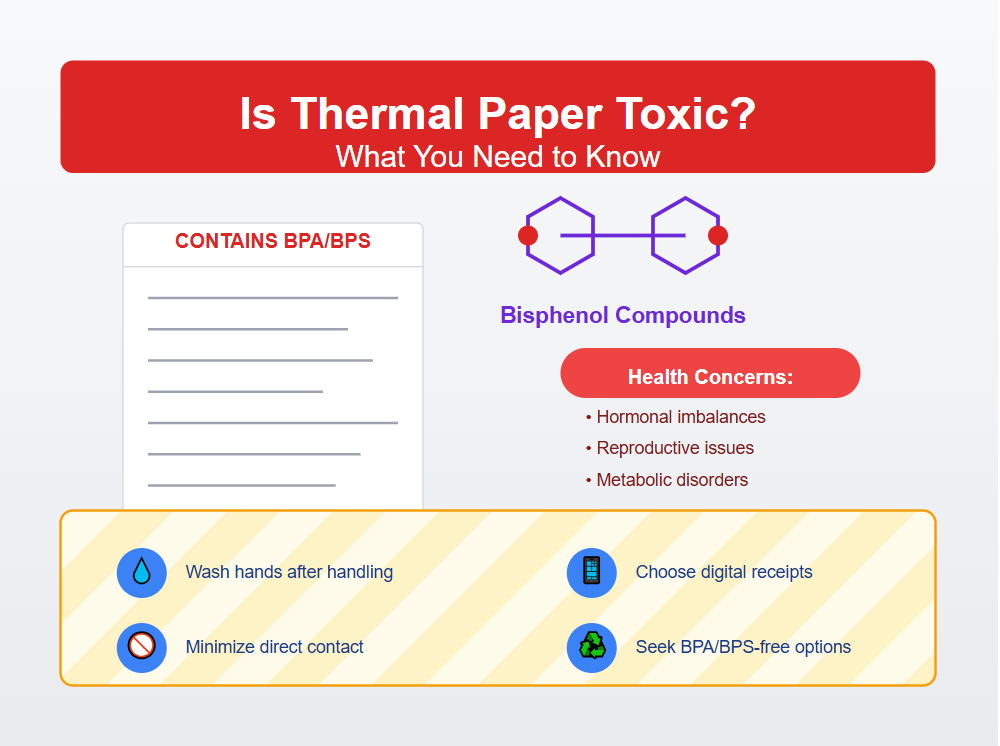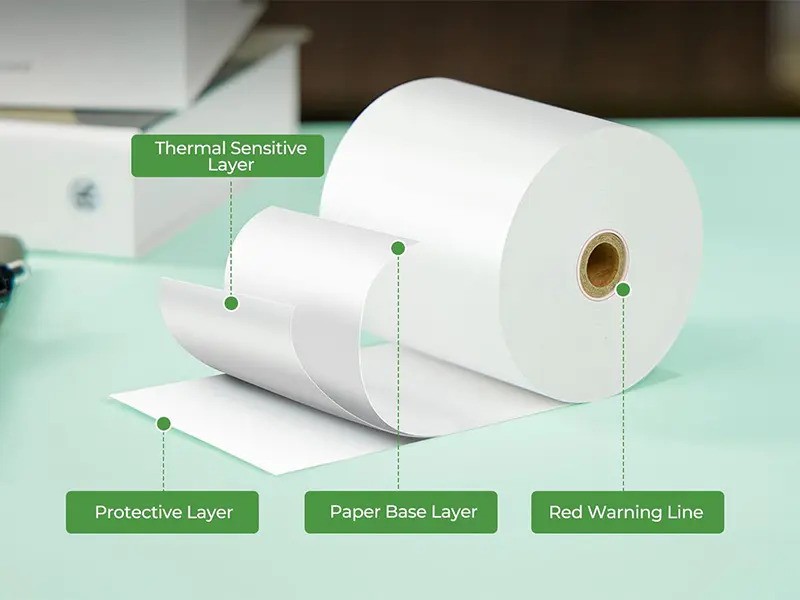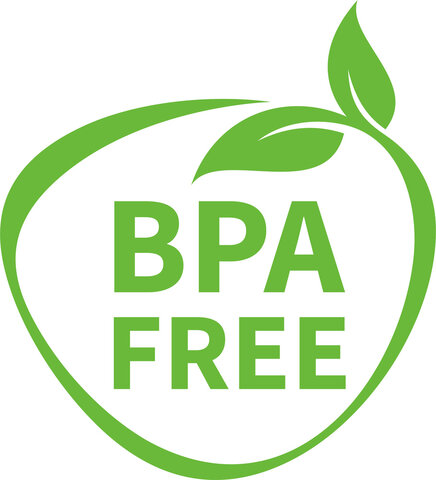
Did you know your shopping receipts might actually be toxic? Every day, we handle thermal paper in receipts, movie tickets, and labels. But recent studies suggest these papers often contain harmful chemicals called BPA and BPS.
In this post, you'll learn about the risks of thermal paper, how it affects your health, and ways to stay safe.
What is Thermal Paper?
Thermal paper is a specialized type of paper that contains heat-sensitive chemical compounds, allowing it to change color when exposed to heat rather than requiring ink or toner. Unlike regular paper, thermal paper has a coating of chemicals that includes developers (often BPA or BPS) and colorless dye precursors that react when heated.

How Thermal Printing Works
The thermal printing process is straightforward yet ingenious. When heat from the thermal printhead is applied to the paper, the developer (such as BPA) reacts with the proto-dye in the coating, producing a dark color where the heat was applied. This chemical reaction creates the printed text and images without the need for ink cartridges or ribbons, making thermal printers low-maintenance and cost-effective for many businesses.
Common Uses of Thermal Paper
Thermal paper is ubiquitous in our daily lives, appearing in numerous forms:
Retail receipts from cash registers and credit/debit card machines
Transportation tickets (airline boarding passes, train tickets)
Entertainment venues (movie theaters, sporting events, amusement parks)
Labels for prescription bottles, packaged deli meats and cheeses
Medical applications like ultrasound and ECG printouts
Shipping labels and package tracking information
Quick Tip: You can easily identify thermal paper by scratching the printed surface with your fingernail or a coin. If a dark mark appears, it's thermal paper containing chemical developers.
To learn more about Thermal Paper, click this article.
Chemicals in Thermal Paper
Thermal paper contains several chemicals that enable its heat-activated printing properties, but some of these compounds have raised significant health concerns among researchers and health professionals.

Bisphenol A (BPA)
Bisphenol A, commonly known as BPA, is a chemical widely used to create strong, clear plastics and resins. Surprisingly, BPA is also commonly used in thermal papers, which we handle daily through receipts and tickets.
How Does BPA Affect Your Health?
BPA is an endocrine disruptor, meaning it interferes with your body's hormones, particularly estrogen. Even small amounts absorbed through skin contact can disrupt the endocrine system, potentially causing:
Reproductive issues: BPA exposure has been associated with fertility problems, increased risk of miscarriage, premature delivery, and hormonal imbalances.
Obesity and Diabetes: Because BPA affects hormones related to metabolism, studies have linked higher exposure to increased risks of obesity and diabetes.
Attention Disorders (ADHD): Exposure during childhood is particularly concerning, as BPA has been connected to attention deficit hyperactivity disorder (ADHD), affecting brain development and behavior.
Bisphenol S (BPS)
Manufacturers aware of BPA's risks often market "BPA-free" thermal paper. Unfortunately, many of these alternatives use Bisphenol S (BPS), a chemical with a similar structure—and similarly harmful effects.
BPS also acts as an endocrine disruptor, carrying many of the same health concerns as BPA. Ongoing research indicates that BPS exposure may lead to hormonal issues, reproductive difficulties, and developmental problems in children.
Here's a quick comparison:
| Chemical | Usage in Thermal Paper | Endocrine Disruptor | Health Concerns |
| BPA | Commonly Used | ✅ | Reproductive issues, obesity, ADHD |
| BPS | BPA Substitute | ✅ | Similar health risks as BPA |
Other Chemicals Used in Thermal Paper
Apart from BPA and BPS, thermal papers may also contain various chemicals such as developers, stabilizers, and sensitizers. Though these chemicals are usually present in smaller amounts and considered less hazardous, they may still pose irritation risks or allergic reactions in sensitive individuals.
How BPA and BPS Exposure Happens
Every time you handle a thermal paper receipt, boarding pass, or ticket, you're potentially coming into contact with harmful chemicals like BPA and BPS. But exactly how do these chemicals enter your body, and why should you care?
Handling Thermal Paper Directly
Cashiers and Frequent Contact
Cashiers and retail workers face substantially higher exposure risks due to their occupational handling of receipts. Unlike occasional consumer contact, these workers may handle dozens or even hundreds of thermal paper receipts daily, significantly increasing their cumulative exposure.
"If you have ever watched a cashier handle thermal paper, they typically hold it between thumb and forefinger (or thumb and first two fingers) for only a few seconds."
While each individual contact may be brief, the frequency creates a pattern of repeated exposure throughout work shifts. Even with the rapid inactivation of BPA in the body, continuous handling throughout the day presents elevated risk.
Absorption Through Skin
The mechanism of exposure occurs through direct transfer from paper to skin. Research has identified several key factors affecting absorption:
Transfer coefficients - Studies have measured transfer rates ranging from 1,072 ng/s to 21,522 ng/s
Contact duration - Longer handling time increases transfer amounts
Skin surface area - Larger contact area enables greater absorption
Absorption factors - Between 2.3% and 27% of BPA transferred to skin enters the bloodstream
Critical risk factors that enhance absorption:
Use of hand sanitizers (increases absorption by up to 185 times)
Application of moisturizers and other skin products
Wet or sweaty hands
Touching food immediately after handling receipts
Environmental Exposure
Beyond direct skin contact, BPA and BPS pose environmental risks. Once these chemicals enter the environment, they don't break down easily, lingering in water, soil, and wildlife habitats.
Persistent Pollution:
Discarded receipts and other thermal paper products eventually end up in landfills, releasing BPA and BPS into the environment. Due to their resistance to degradation, these chemicals build up, contaminating ecosystems and potentially entering the food chain.
Water and Soil Contamination:
Rain and runoff can carry these persistent chemicals into rivers, lakes, and groundwater. Over time, wildlife and even humans can indirectly absorb BPA and BPS through contaminated water sources, raising broader ecological concerns.
Potential Health Risks of Thermal Paper Exposure
Thermal paper contains chemicals like BPA and BPS, which can easily enter your body through skin contact. Long-term or repeated exposure to these substances may lead to serious health problems, particularly affecting your endocrine system, reproductive health, metabolism, behavior, and even increasing cancer risks.
Hormonal Imbalances
BPA and BPS are known endocrine disruptors that can interfere with the body's hormonal systems. These chemicals mimic estrogen, though at 10,000-100,000 times weaker potency than natural hormones. Despite this relative weakness, chronic exposure may:
Disrupt natural hormone signaling pathways
Alter thyroid function
Create chronically high estrogen levels
Interfere with normal endocrine system function
Reproductive and Developmental Issues
The estrogenic properties of BPA and BPS make reproductive health especially vulnerable:
Fertility problems: Prolonged exposure is associated with lower fertility in both men and women, including reduced sperm quality and difficulty conceiving.
Early puberty: Hormone disruption from these chemicals can trigger premature puberty, particularly in girls.
Pregnancy complications: BPA exposure during pregnancy may increase risks of miscarriage, premature birth, and developmental issues in infants.
Metabolic Disorders
Emerging research suggests connections between bisphenol exposure and metabolic health problems:
Obesity: BPA has been found in over 90% of American adults and children, with higher levels associated with increased body mass
Diabetes: Disruption of insulin signaling and glucose metabolism
Heart Disease: Studies have identified links between BPA exposure and cardiovascular issues
Behavioral Changes and Hyperactivity
Exposure isn't limited to physical effects; your brain health can also suffer. Children exposed to high BPA or BPS levels have shown increased hyperactivity, attention deficit disorders (ADHD), and other behavioral changes. Developing brains are particularly sensitive to these endocrine-disrupting chemicals.
Cancer Risks
Long-term BPA exposure is increasingly connected to certain types of cancer, particularly those influenced by hormonal factors, such as:
Breast cancer
Prostate cancer
This increased cancer risk likely arises from chronic hormonal disruption and altered cell growth and repair processes.
Summary of Health Risks:
| Health Concern | Affected Group | Link to BPA/BPS Exposure |
| Hormonal imbalances | Adults and children | Mimics estrogen; disrupts endocrine system |
| Fertility & reproduction | Adults, especially pregnant women | Infertility, early puberty, miscarriages |
| Metabolic disorders | Adults and children | Increased diabetes, obesity risk |
| Behavioral & developmental | Primarily children | Hyperactivity, attention disorders |
| Cancer | Adults | Increased breast and prostate cancer risk |
Studies on BPA in Thermal Paper
Scientific research has demonstrated significant BPA presence in thermal paper, with several key studies quantifying exposure risks. These investigations provide critical data on concentration levels and absorption mechanisms.
Liao and Kannan Study
In one of the most comprehensive investigations, Liao and Kannan analyzed 103 thermal receipt papers for BPA content. Their findings revealed:
Geometric mean BPA concentration of 211 μg/g
Widespread BPA presence across various thermal paper products
Significant variability depending on paper source and manufacturer
Biedermann et al. Study
In another critical research, Biedermann et al. reported even higher BPA concentrations, suggesting more severe potential exposure from thermal receipts:
Mean BPA concentration of 13.3 mg/g (approximately 63 times higher than Liao and Kannan's findings)
Transfer coefficient of 21,522 ng/s (measuring how quickly BPA moves from paper to skin)
27% absorption factor from live hands after direct application
Hormann et al. Study
The Hormann team's research revealed alarming data about skin permeation:
"BPA levels went up to 185 times higher, 'an absolute monster effect,' after the use of skin products such as hand sanitizers, sunscreens, and moisturizers."
Their study documented:
Maximum BPA concentration of 26.3 mg/g in thermal paper
Transfer coefficients of 1,072-1,838 ng/s
Dramatic absorption increase with "dermal penetration enhancers" in common skin products
Estimated Daily Intakes
Researchers developed a mathematical model to estimate BPA exposure:
Formula: EI = [(k×c×HF×HT×AF/10^6)×SF]/BW
Where:
EI = Estimated intake
k = Transfer coefficient (paper to skin)
c = BPA concentration
HF = Handling frequency
HT = Handling time
AF = Absorption factor
SF = Surface area scaling factor
BW = Body weight (standardized at 70 kg)
The calculated daily intake varies dramatically based on these variables:
| Scenario | Concentration | Transfer Rate | Absorption | Estimated Intake (ng/kg/day) |
| Minimal | Low | Low | 2.3% | 51.1 ± 0.80 |
| Moderate | Low | Medium | 8.6% | 327.7 ± 5.14 |
| High | High | Medium | 27% | 126,765 ± 1,988.2 |
| Extreme | High | High | 27% | 1,484,351 ± 23,281.3 |
These studies demonstrate that thermal paper handling can potentially lead to significant BPA exposure, particularly with frequent contact or when combined with skin products.
Reducing Exposure Risks
While thermal paper remains ubiquitous in daily life, several practical strategies can significantly reduce your exposure to potentially harmful chemicals like BPA and BPS. Implementing these protective measures is particularly important for pregnant women, children, and those with frequent occupational exposure.
Minimizing Contact with Thermal Paper
The most effective strategy is simply limiting your physical contact with thermal receipts:
Opt for digital alternatives: Many retailers now offer email or text message receipts
Decline receipts when they're not necessary for returns or expense tracking
Handle with care: If you must accept a receipt, touch only the non-glossy backside
Develop new habits: Ask cashiers to place receipts directly in bags rather than handing them to you
"Don't accept receipts whenever possible... Go with a paperless receipt via email or text message. This is an increasingly available option at many retailers."
Proper Storage of Receipts
When receipts are necessary, proper storage prevents chemical transfer to other surfaces:
Use dedicated envelopes for receipt storage
Avoid storing loose receipts in wallets or purses
Keep receipts separate from currency and credit cards
Consider taking photos of important receipts and discarding the originals
Important: BPA readily transfers from receipts to other items they contact, including cash in your wallet and the lining of purses or pockets.
Washing Hands After Handling
Hand hygiene plays a crucial role in limiting absorption:
| Timing | Action | Effectiveness |
| Within 4 minutes | Wash with soap and water | High - prevents absorption |
| After 4 minutes | Wash with soap and water | Moderate - some absorption already occurred |
| Any time | Use hand sanitizer | Negative - increases absorption dramatically |
Critical warning: Never use hand sanitizer immediately after handling thermal paper. Research shows sanitizers can increase BPA absorption by up to 185 times due to their "dermal penetration enhancers."

Gloves for Occupational Exposure
Workers with frequent thermal paper contact should implement additional protections:
Wear latex gloves when handling receipts regularly
Change gloves frequently during shifts
Request BPA/BPS-free thermal paper from employers
Wash hands thoroughly before breaks, especially before eating
Keep work areas clean to prevent cross-contamination
These practical measures can significantly reduce your exposure to potentially harmful chemicals in thermal paper without major lifestyle disruptions.
Conclusion
Thermal paper receipts seem harmless but contain chemicals like BPA and BPS that may harm your health.
Convenience shouldn't come at the cost of health risks like hormonal issues, obesity, or even cancer.
Choose digital receipts, store printed ones carefully, wash your hands after touching, and wear gloves if handling regularly.
Small changes can help you avoid unnecessary exposure and keep you healthy.
Frequently Asked Questions
Q: How do I know if my thermal paper has BPA?
A: Perform a simple scratch test on the printed side of the paper using your fingernail or a coin. If the scratched area turns dark, it likely contains BPA or similar developers. This works because the friction activates the heat-sensitive chemicals in the paper.
Q: Is thermal paper safe for kids?
A: Thermal paper poses higher risks for children as they are more vulnerable to endocrine-disrupting chemicals. BPA and BPS can interfere with developing hormonal systems. Children may also transfer chemicals from receipts to their mouths, increasing exposure risk. Parents should minimize children's contact with thermal paper.
Q: Are thermal paper cameras toxic?
A: Instant-print cameras using thermal technology may contain BPA and BPS chemicals that can disrupt hormone function. Children's cameras particularly raise concerns as kids may frequently handle the prints. Look specifically for cameras advertised as "BPA-free" and "BPS-free" or those using alternative printing technologies like ZINK.
Q: Why is thermal paper toxic?
A: Thermal paper contains high concentrations of endocrine-disrupting chemicals like BPA—up to 1,000 times more than found in canned foods. These chemicals easily transfer to skin when handled and can be absorbed into the bloodstream, potentially causing hormonal imbalances, reproductive issues, and other health problems over time.
Q: Can I recycle thermal paper?
A: Thermal paper should not be recycled with regular paper. The BPA and BPS in receipts don't break down easily and can contaminate the recycling stream, potentially transferring to new paper products. These chemicals pose environmental pollution concerns when disposed of in either recycling or regular waste.
Q: Is all thermal paper toxic?
A: Not all thermal paper contains harmful chemicals. While traditional thermal paper uses BPA or BPS as developers, manufacturers now produce truly non-toxic alternatives using organic coatings. However, many "BPA-free" options simply substitute BPS, which may pose similar health risks. Check product labeling for papers specifically marked BPA-free and BPS-free.



























